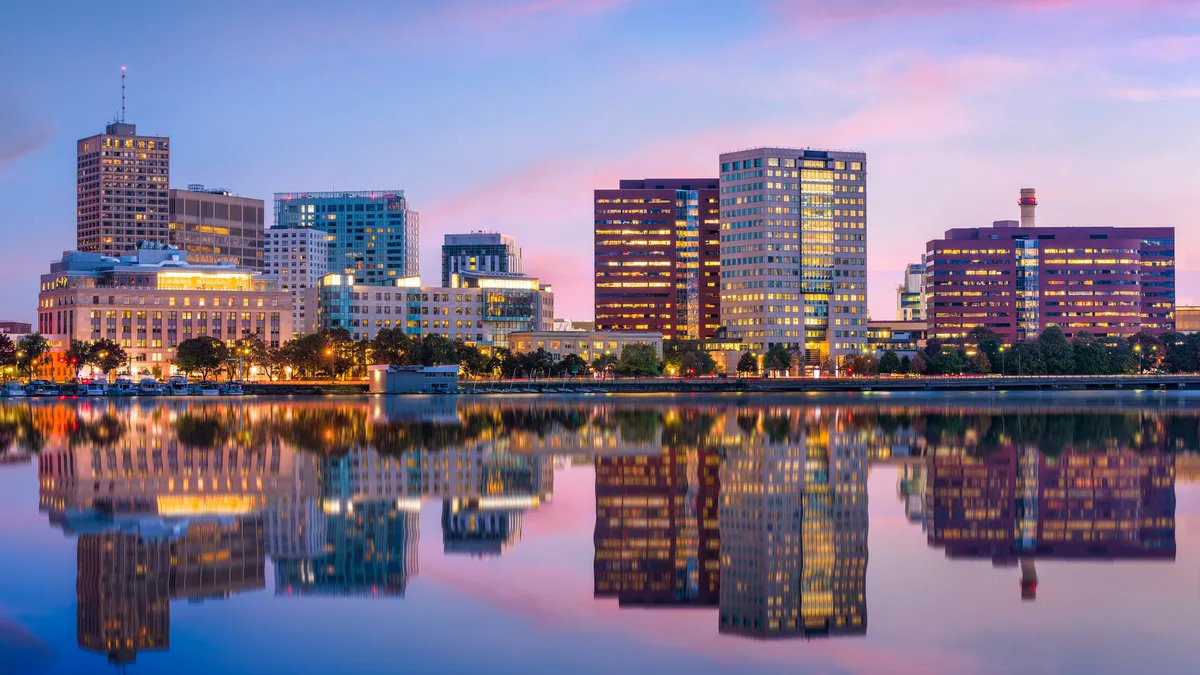Dive Brief:
- Cambridge, Massachusetts, on Monday adopted requirements that all existing nonresidential buildings over 25,000 square feet achieve net-zero greenhouse gas emissions by 2050, with a more aggressive deadline of 2035 for the largest buildings.
- Cambridge said in a Tuesday news release it’s the “first known city in the country” to adopt such ambitious requirements. Most other building performance standards in the country have later net-zero deadlines, typically around 2050, said Susanne Rasmussen, the city’s director of environmental and transportation planning.
- Emissions-based building performance standards such as these are gaining traction in jurisdictions nationwide as a key tool to drive down climate pollution from existing buildings.
Dive Insight:
“Building performance standards are the most powerful way to decarbonize existing buildings,” said Rajiv Ravulapati, associate director of government engagement at the Institute for Market Transformation, in an interview.
The nonprofit has helped jurisdictions across the U.S., including Cambridge, develop standards that require building owners to meet certain targets over time to reduce energy use or greenhouse gas emissions. Policymakers are increasingly leaning toward basing standards on the latter, according to a May analysis of these policies by the American Council for an Energy-Efficient Economy.
Interest in these policies has taken off since the White House launched the National Building Performance Standards Coalition in January 2022, said Alexandra Laney, IMT’s associate director of communications. Just this week, Maryland announced it would join the coalition of mayors, governors and county executives working to design and adopt building performance standards by Earth Day 2024.
The building sector presents a major opportunity — and challenge — in the nation’s effort to prevent worsening climate change. About a third of U.S. greenhouse gas emissions come from buildings, including the electricity used in them. In some cities, buildings are responsible for as much as half to three-quarters of climate emissions, according to IMT.
More than two years in the making, Cambridge’s newly adopted standards are an update to a 2014 ordinance that required owners of commercial, institutional and large multifamily buildings to track and report their energy and water use.
Under the new amendments, nonresidential buildings covered under the ordinance must eventually stop burning fossil fuels on site, explained Rasmussen, the city’s environmental and transportation planning director. Building owners must effectively power their buildings with renewable energy, either by investing in solar panels or purchasing a contract for renewable energy, she said.
The renewable energy doesn’t have to be generated locally. The Massachusetts Institute of Technology, for example, purchases power from a solar provider in North Carolina, she said.
It will be a “big lift” for Cambridge’s large universities to decarbonize their massive district energy systems, IMT’s Ravulapati told Smart Cities Dive in an email, because universities often have extensive, complex and older energy infrastructure and limited resources.
“Decarbonizing district energy systems often requires significant financial resources,” he wrote in an email. “Major universities have numerous competing priorities for their limited budgets, including academic programs, research, student services, and facility maintenance.”
The city promised in its Tuesday news release to support property owners with “robust technical assistance and connections to incentives,” but Ravulapati said “we'll have to see what they design and deliver.”
The city has 314 buildings facing the 2035 net-zero deadline. They can continue burning fossil fuels on site if owners purchase verified carbon credits, but only until 2050 and only to offset limited amounts of emissions, Rasmussen said. This exception was put in place to make it more feasible for owners to meet the tighter deadline, she added.
She added that the city plans to develop local carbon credits, which building owners choosing to use carbon credits will be required to use if they are available.
If building owners want to continue burning fossil fuels on site and don’t want to purchase carbon credits, they can opt to pay the city for alternative compliance credits. Cambridge will invest this money into projects that reduce carbon emissions, such as retrofits to large residential buildings not covered by the amendments, Rasmussen said. Building owners that fail to meet the emissions reductions requirements will be given a written warning for their first violation and potentially face daily fines of up to $300 per violation.
The city will undergo a separate process to develop regulations requiring greenhouse gas emissions reductions in residential buildings, Rasmussen said. Amid a housing crisis, residential buildings may require a different approach, she said.












